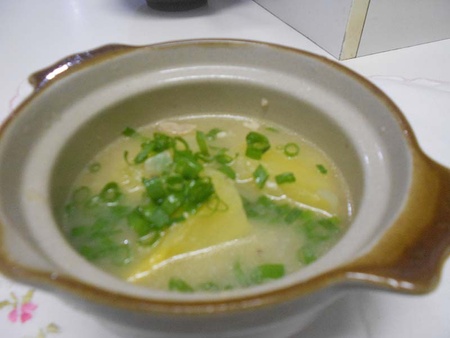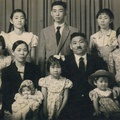My mother came to Brazil when she was three years old and since childhood learned to eat all that nature could offer, already being able to tell what was edible. Even geckos, nine-banded armadillos; in short, just about anything that appeared in front of her. She was married at the age of 14 and a short time later went to live in a small farm in the town of Bastos.
I remember how she prepared everything with simple seasoning like salt, garlic, lime, pork fat, leek, and ginger. Everything she cooked turned out to be delicious. My father had a refined palate and gave my mother many suggestions, for she was still very young. He knew how to make tempura with tender carrot leaves, which was very crunchy because he mixed in cachaça [Brazilian rum; “our whisky”] with the flour. They used everything available: in my mother’s hands, whatever they could find in the woods was turned into a dish. I miss those days very much.
There was a weed called picão that was abundant in the area and that today is used as a medicinal herb. Well, for my mother the softer picão leaves were a substitute for horenso [spinach], which was unavailable at that time. She made an ohitashi that we all liked, seasoned with sumiso (miso, lime, and sugar).
Her fukujinzuke preserve was special: made in large quantities to be divided among her children, all married, and using the season’s vegetables. It took a week for it to be ready and the result was a mix of crunchy legumes that, just thinking about it, makes my mouth water—these days, I don’t know anyone who makes as tasty a preserve as hers used to be. Carrots, chayote, eggplant, daikon, gobo, all cut into little cubes. On the first day, they were preserved in salt, with an omoshi on top; the next day, she squeezed the legumes to remove their moisture, tossing it out.
Separately, she made a broth consisting of dried fish, seasoned with shoyu and sugar. After removing the broth from the fire, she waited for it to cool down and then mixed the broth with the legumes, adding to the mix a kind of pepper we call “lady’s finger” [a type of chili that isn’t too spicy]. At night, she put the omoshi back in place until the next day.
She repeated this procedure during the course of five consecutive days.
Each morning, she removed the omoshi, squeezed the broth out of the legumes so that only the broth itself went into the fire, and on the last day, if necessary, she added shoyu or sugar or water. Once the broth cooled down, she again mixed it with the legumes—and Mrs. Shizuka’s crunchy fukujinzuke was ready. It was then stored in glass jars where it could stay out of the fridge for six months without losing its flavor.
The miso my mother made was just too good; it was also made in large quantities to be distributed among her nine children. She made it once a year until the age of 85. She stopped making it only because it became too difficult for her to do this manual task which required strength.
All I know is that the grandchildren loved the misoshiru made with “obaachan’s miso.” When it came to the miso bought in the supermarket, even if they didn’t know where the miso had come from, none of them could eat it, such was the difference.
At first, her miso was light-colored, but with the passing months it became both increasingly dark and flavorful.
Now I will tell you how my mother made her special misoshiru, the real ofukuro no aji.
First, she cut off the meatier parts of the chicken and set them aside for other dishes. She then rubbed lime on what was left of the chicken so as to remove its peculiar odor, and washed it thoroughly. Following that, she prepared the broth, boiling it along with diced onions in a covered iron skillet until the bones became soft. Next, she put large slices of peeled cassava into the broth. (Preferably yellow cassava, which was more flavorful and widely available in the area.) She heated the mix until the cassava softened, while making sure it didn’t actually melt. At the end, she added the miso and, after bringing it to the boiling point, turned off the fire.
When it was meal time, she poured the broth into individual bowls, with the bits of cassava and leek on top. It was delicious when hot, especially in wintertime.
Today, as I no longer have the privilege of having “obaachan’s miso” at home and I lack both my mother’s patience and ability, when I make misoshiru I must add aji-no-moto and other things to enhance its flavor. For those who like to experiment, I recommend you strain the broth before adding the cassava.
When I decided to take part in ITADAKIMASU!, I rounded up all the ingredients and made my mother’s special misoshiru.
I became overwhelmed with emotion and happiness because I was then able to reduce a little the feeling of missing my mother, as of September it was Sankaiki (2 full years) since she left us at the age of 95.
* * * * *
Our Editorial Committee selected this article as one of their favorite Itadakimasu stories. Here are their comments.
Comment from Laura Hasegawa:
While not wanting to dismiss the other stories, this was an amazing narrative. After all, besides offering old family recipes that were as complicated as they were delicious, it gave us a glimpse into the lives of the first immigrants. How could I ever have imagined that geckos and nine-banded armadillos ended up on the dinner table, right next to gohan and misoshiru?
I’ve read a lot about the lives of the first immigrants, but I found Rosa Takada’s story quite moving, making me stop and think about the lives of extreme hardship of the pioneers. It’s incredible how creative they were in the kitchen! Hats off!
Comment from Alexandre Ratsuo Uehara:
First, I would like to congratulate the initiative of Discover Nikkei in encouraging people to relate their personal stories with food. I can say from my own experience, that Japanese cuisine is one of the strongest contributions of Japanese culture for Brazil. For example, in metropolitan cities like São Paulo, there is Japanese food in almost all the steakhouses.
I selected the article “Ofukuro no aji: Mrs. Shizuka’s cassava misoshiru” written by Rosa Takada, because it involves the reader with a wealth of detail. An example is when the name of each ingredient is mentioned and she describes the process for making the food. This narrative ends up stimulating sensations and provoking emotions in the reader.
The article also engages the reader, in my opinion, when the author mentions the actions of her mother, the distribution of miso among her brothers and how the misoshiru made with obaacham’s miso was enjoyed by grandchildren.
In the end, the author transports the reader from the past to the present when she related that made her mother special misoshiru with the same ingredients. And the biggest attempt to involve the reader and when she invites everyone to have the same experience, putting into practice the recipe.
© 2012 Rosa Tomeno Takada







